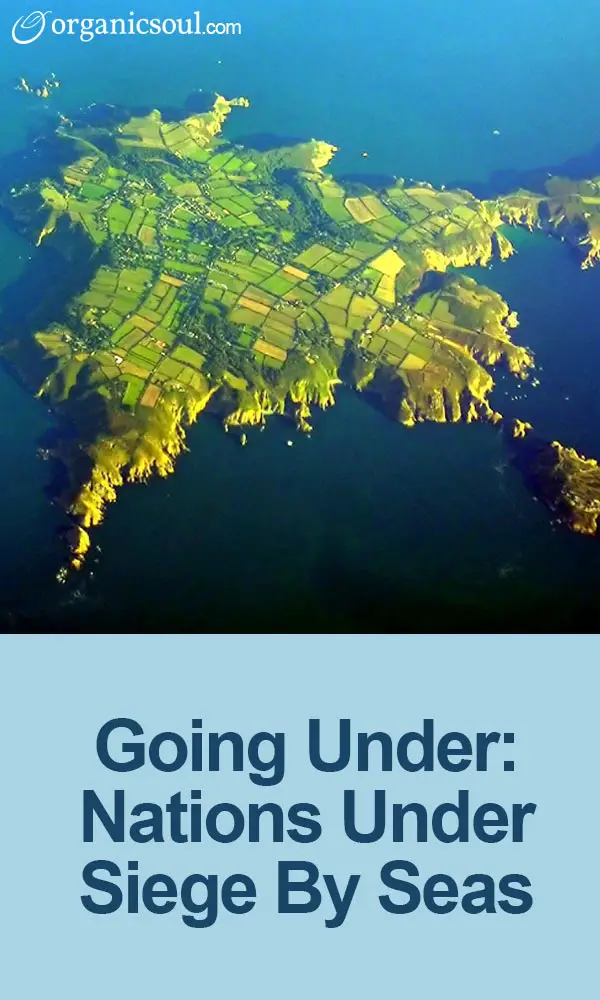An AP report raised an interesting question last week: if seas swallow an island state, is it still a nation? With water rising worldwide, some parts of countries – and some entire countries themselves – have been facing the rising tide with wavering eyes. Truly, there is no simple solution. Locals tirelessly spend their days piling rocks in front of their home, but whether that can last is a question with dim prospects.
Like Organic Soul on Facebook
A number of places across the globe are seeing the same epidemic. As melting ice sheets and glaciers pour into oceans at unthought-of levels, scientists are attempting to understand the issue and provide practical solutions. Scientists at the University of Arizona say that by 2100, ocean levels will have risen 13-20 feet, and what’s more, the Antarctic will be in an irreversible decline. This forces us to reconsider our environmental policies and reexamine our approach to global climate solutions.
The Marshall Islands
With its highest point at a meager 30 feet above sea levels, the Marshall Islands serves as a poster child for problems associated with sea level rise. Located in the North Pacific, the Marshall Islands are largely composed of reefs and atolls. Over 60,000 people live on the islands, and every one of them is fearful of submersion.
Unfortunately, international law fails to guide the nation and its leaders. While the modern world has witnessed nations absorbed from foreigners, overthrown from within, and even peacefully seceded, it has yet to confront the issue of a nation disappearing. The real questions are where will the 61,000 Marshallese go? What will happen to their U.N. seat? And what will happen to their resources and way of life?
Mumbai, India
Fly further west and you’ll reach Mumbai, India, a city of 14 million people and of great national importance. The city has one of the highest GDPs in all of Asia, making it India’s richest. Income, however, is not something Mother Nature acknowledges. Unfortunately, many parts of the city lay just 30 feet about sea level.
In fact, due to the rising water all over the coast of India, it has made the list of 27-nations most vulnerable to sea-level rise. Furthermore, weather models predict an increasing occurrence of storms like those seen in 2005 that caused extensive damages and killed over 1000 people. While India may not need to worry about becoming totally submerged, the displacement of millions and loss of a national treasure is a palpable threat.
Atafona, Brazil
Since the 1950’s, Atafona has witnessed the sea swallow up hundreds of homes along the coast. According to researchers, low-lying Atafona is seeing an average 10 feet a year disappear. Over the same 60 year period, the residents have seen an astonishing 14 city blocks disappear. While some argue that this may due to natural sea level erosion in the area, researchers are hard pressed at explaining the 60-year-trend that only gets worse. Many are unmoved by the natural erosion argument, stating that it is clear our poor environmental habits and lack of concern with climate change will lead to the end of many people's well being.
Atafona, like Mumbai and the Marshall Islands, is just another place in the world with global warming knocking at the door.
Hawaii, United States
In case you thought sea level rise only affected countries outside of the United States, we have some disconcerting news for you. As modeled by Kailua, Hawaii, many of the Hawaiian islands are facing relentless sea rise. So far, “70 percent of Kauai's beaches are eroding while Oahu has lost a quarter of its sandy shoreline.”
This hold dim prospects for both Hawaiian natives and tourists. The 11 billion dollar industry, famous for its massive sandy beaches, is being forced to retreat further and further back to the mainland and tree line. Even some of the wildlife is feeling the effects, as the Hawaiian monk seal and green sea turtle both depend on plenty of beach space in continuing their species.
According to some researchers, the trend started in the early 20th century has been steadily getting worse, most likely exacerbated by human activity like building seawalls and jetties, along with the dredging of stream mouths. Global warming and unsustainable practices are truly devastating the environment. That said, these two factors together spell a major threat for the United States’ favorite vacation spot.
What to Do?
Now, more than ever, is the time to take action in the fight against global warming. Making changes in your daily life to decrease your carbon footprint is just one option. Each one of us needs to pressure our leaders to comprehensively approach the problems and develop well-documented and practical research. Funding education for alternative energy and new solutions is a must.
Even if our own people don’t see an immediate threat of sea level rise, thousands and millions of others around the globe do, and we have the moral obligation to work hard at solving problems and producing solutions for everyone. The corners of the world will forever be locked in a symbiotic relationship; if one part of the earth is changing, all the other parts will be changing too.















